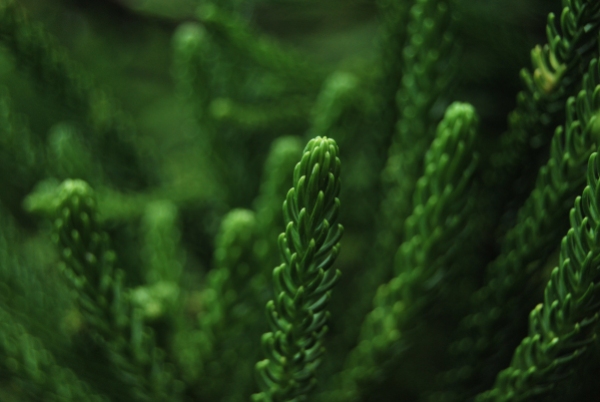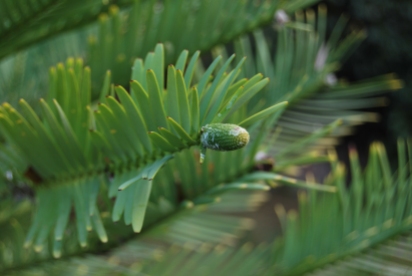Who could compete with the angiosperms?
“The redwoods, once seen, leave a mark or create a vision that stays with you always. No one has ever successfully painted or photographed a redwood tree. The feeling they produce is not transferable. From them comes silence and awe. It’s not only their unbelievable stature, nor the color which seems to shift and vary under your eyes, no, they are not like any trees we know, they are ambassadors from another time.” John Steinbeck from Travels with Charley in search of America
Some of the most impressive trees on earth are conifers: a redwood (Sequoia sempervirens) is the tallest tree in the world and a bristlecone pine (Pinus longaeva) is the oldest. Yet, redwoods (plants of the subfamily Sequoioideae) and several other conifers are often considered to be relics, primitive survivors from a distant era (Figure 1). Many would agree with Steinbeck’s sentiment that conifers are ambassadors from another time.
Indeed, the three extant genera known colloquially as the “redwoods” – Sequoia, Sequioadendron and Metasequoia – are all that remain of a once-much larger, ancient sub-family: the Sequoioideae. The fossil record shows that the Sequoioideae were widespread in the Cretaceous (about 140 to 70 million years ago), being particularly dominant in northern latitudes. However, the reign of the redwoods began to draw to a close in the late Eocene and continued throughout the Oligocene, when both the range and diversity of Sequoioideae declined. Today only three species cling on in refugial areas in China and California, and all of them are highly threatened by climate change and habitat destruction.
The demise of the redwoods is captured well by the fortunes of the genus Metasequoia. The genus has a very extensive fossil record and was one of the most common taxa in the Cretaceous and Paleocene in the Northern Hemisphere. At least three distinctive fossil species have been described from this era (although there may have been as many as twenty according to some authors). And as if to further emphasize the point that Metasequoia is a remnant genus, the only extant species – Metasequoia glyptostroboides – was first described from fossil material in 1941 and, following the later discovery of living plants in China in 1948, is commonly regarded as a living fossil.
Mirroring the story of the northern hemisphere giants is that of the once-great southern hemisphere conifer family, the Araucariaceae (Figure 2). In the Cretaceous the araucarians were widespread in the southern hemisphere (and even extended into the northern hemisphere). Today, most species are found in moist rainforest refugia in New Caledonia and Papua New Guinea. The number of genera has fallen from approximately six during the Cretaceous to three that are extant. One of the extant genera (Wollemia) contains only a single species (Figure 3). Similar to the story of Metasequoia, Wollemia nobilis was first described from fossils and was only discovered in a refugial valley in Australia in 1994. Another living fossil!
The two most likely reasons for the decline of these noble plant families were climate change and the rise of the angiosperms. Global cooling in the Eocene and Oligocene appear to have had a major impact on conifer diversity and abundance. Aridification and the evolution of fire-adapted flora in many parts of the world may also have contributed to their decline. The flowering plants (angiosperms) also evolved 120 million years ago and have since expanded to fill many of the niches previously occupied by gymnosperms. Angiosperms have been suggested to be more competitive, faster growing and better adapted to fire than conifers. Indeed the angiosperms are truly an incredible group, accounting for over 80% of the roughly 297 000 species of known land plants (Figure 4). In comparison gymnosperms account for less than 0.5%. Angiosperms are the dominant plant forms in the tropics and subtropics: most of the species in the rainforests tend to be angiosperms. Modern broadleaved tree species are the lungs of our planet. If humans had to choose five families to coexist with into the future, we would almost certainly choose the grasses (Poaceae), daisies (Asteraceae), orchids (Orchidaceae), madders (Rubiaceae) and legumes (Fabaceae). Together these five families contain approximately a third of all plant species and contain the most ecologically and economically important species. So for all the splendour and nobility of the gymnosperms, the angiosperms are indispensable.
So it seems as though the Sequoioideae and the Araucariaceae have had their heyday, along with the dinosaurs that once browsed on their foliage. Yet, just as with the dinosaurs, perhaps it is time to reconsider whether this idea pertains to all conifers. The Pinaceae and the Cupressaceae appear to have radiated fairly recently and occupy vast tracts of land, particularly in the boreal zones of the northern hemisphere. Pines (actual pines…and not “pines” from the southern hemisphere) are tremendously important economically. Junipers are both diverse and widespread. Yet, despite their areal dominance, the pines and junipers still tend to be restricted to more marginal growing areas: northern latitudes and deserts or semi-deserts. Species of these families found in the tropics tend to occupy mountain slopes or moist refugia. Few can compete with modern broadleaved species in the tropics.
Only one conifer group that I know of seems to have taken on the angiosperms at their own game in the tropics and done surprisingly well. Surprisingly, the Podocarpaceae have diversified in recent times in the tropics. The reason behind this is linked to their leaf shape. More basal podocarps, such as Lagarostrobos franklinii or Microcachrys tetragona, cling on (just as the redwoods do) in refugial habitats. These more basal species tend to have scale-like leaves and slow growth rates. Yet, a group of species within the Podocarpaceae have developed broader, flattened leaves or phyllodes and more efficient conducting networks in their leaves (Figure 5). These innovations allow them to have relatively high growth rates, which in turn allows them to compete with angiosperms. Evolution never fails to innovate.
Apart from being a natural tale about the underdog triumphing against the odds, this story also provides some deeper insight into how evolution proceeds. It shows how inadequate it is to label species as either “modern” or “ancient”. Instead, it is more accurate to think that all extant lineages are good enough. Conifers, like the dinosaurs, were once the dominant plants on land. As always, whether a lineage persists through time is partly based on luck and partly on innovation. Although many conifer lineages succumbed to the voracity of time others have subsequently persisted and, like many podocarps, have even radiated. Like the birds, these extant lineages are thoroughly modern: they survive and compete successfully with other modern taxa. It is erroneous to think of birds and podocarps as remnant species. Instead, the next time you find yourself ogling over a yellowwood consider how thoroughly modern it is.

















Thanks to Linda-Liisa Veromann for pointing out the correct spelling for Wollemia nobilis. I hope to hear some exciting stories from your road trip around Australia.
LikeLike
Also, the science behind the story is based mainly on conversations with Tim Brodribb and from reading a few of his excellent papers. The one below deals explicitly with the evolution of leaf form in the Podocarpaceae:
Biffin, E; Brodribb, TJ; Hill, RS; Thomas, P and Lowe, AJ (2012) Leaf evolution in Southern Hemisphere conifers tracks the angiosperm ecological radiation. Proc. R. Soc. B. 279: 341-348.
LikeLike